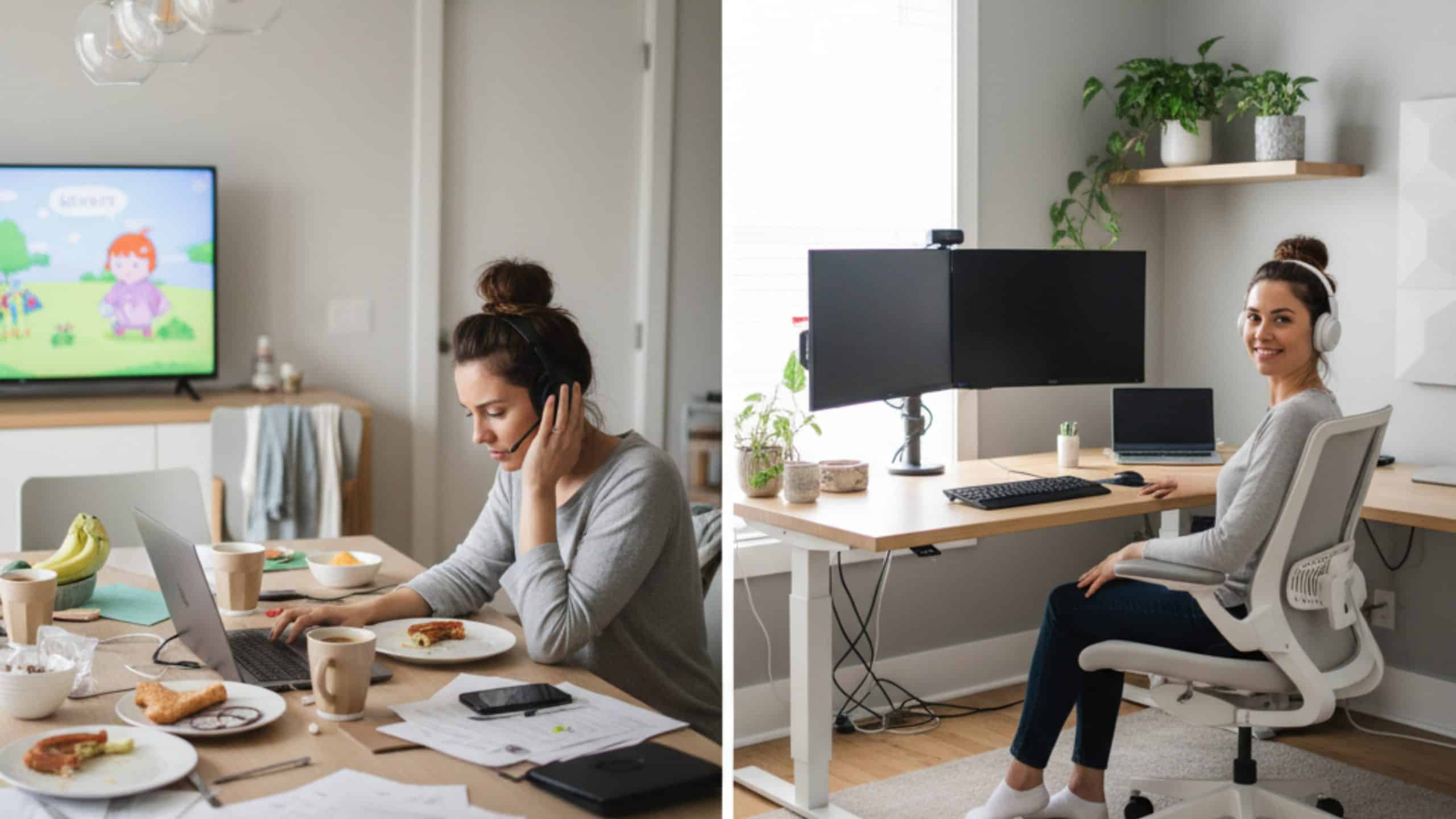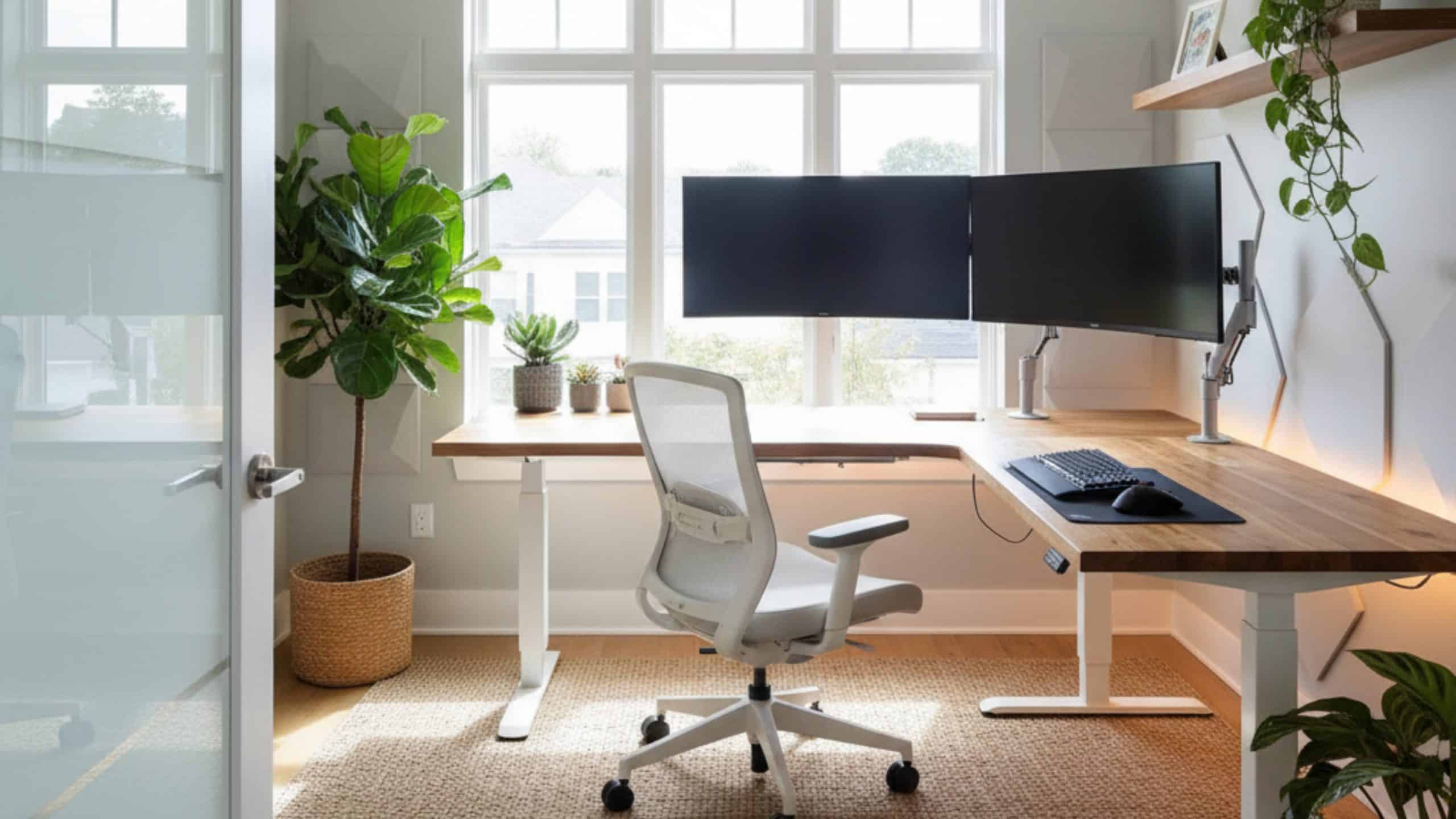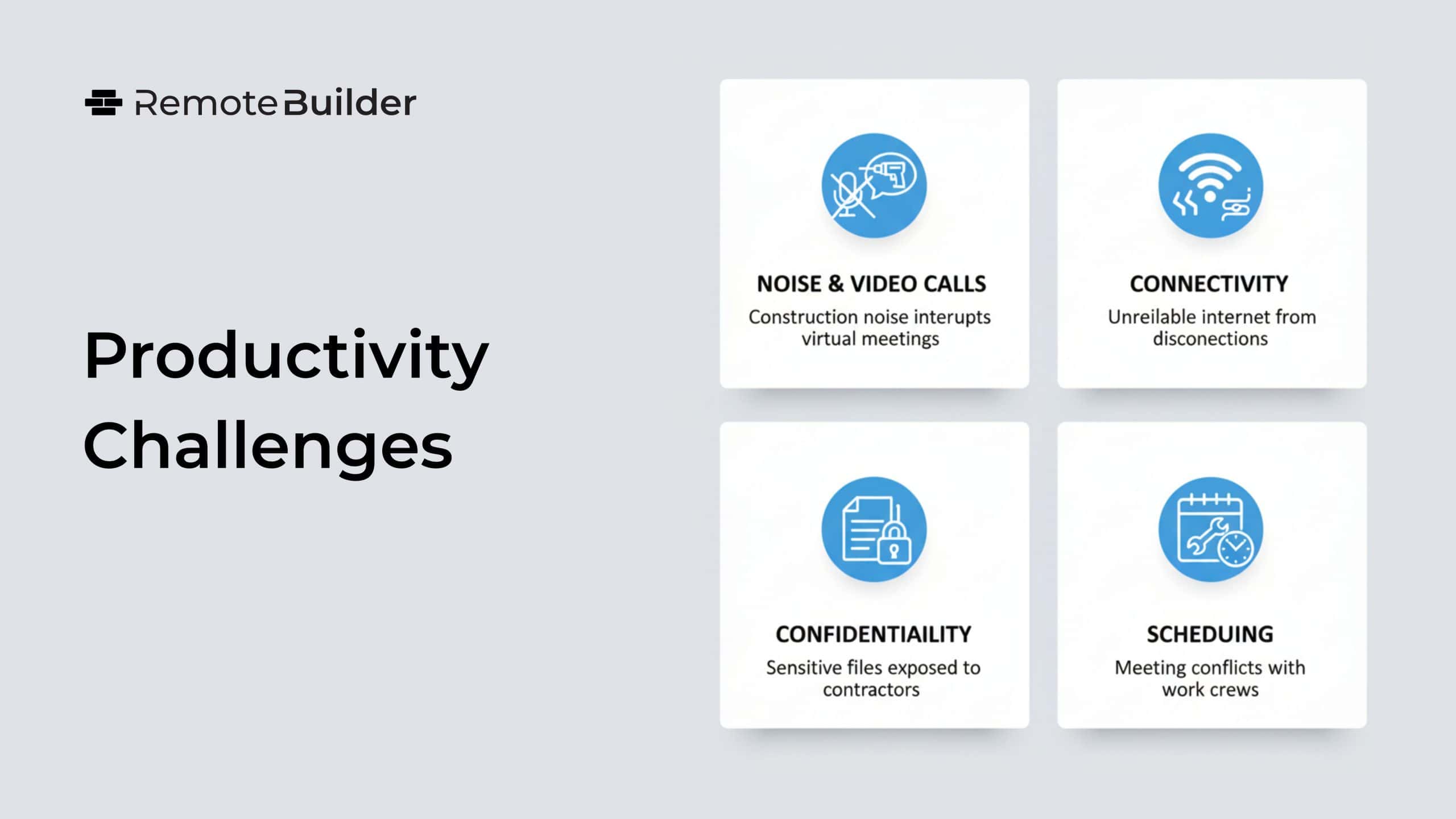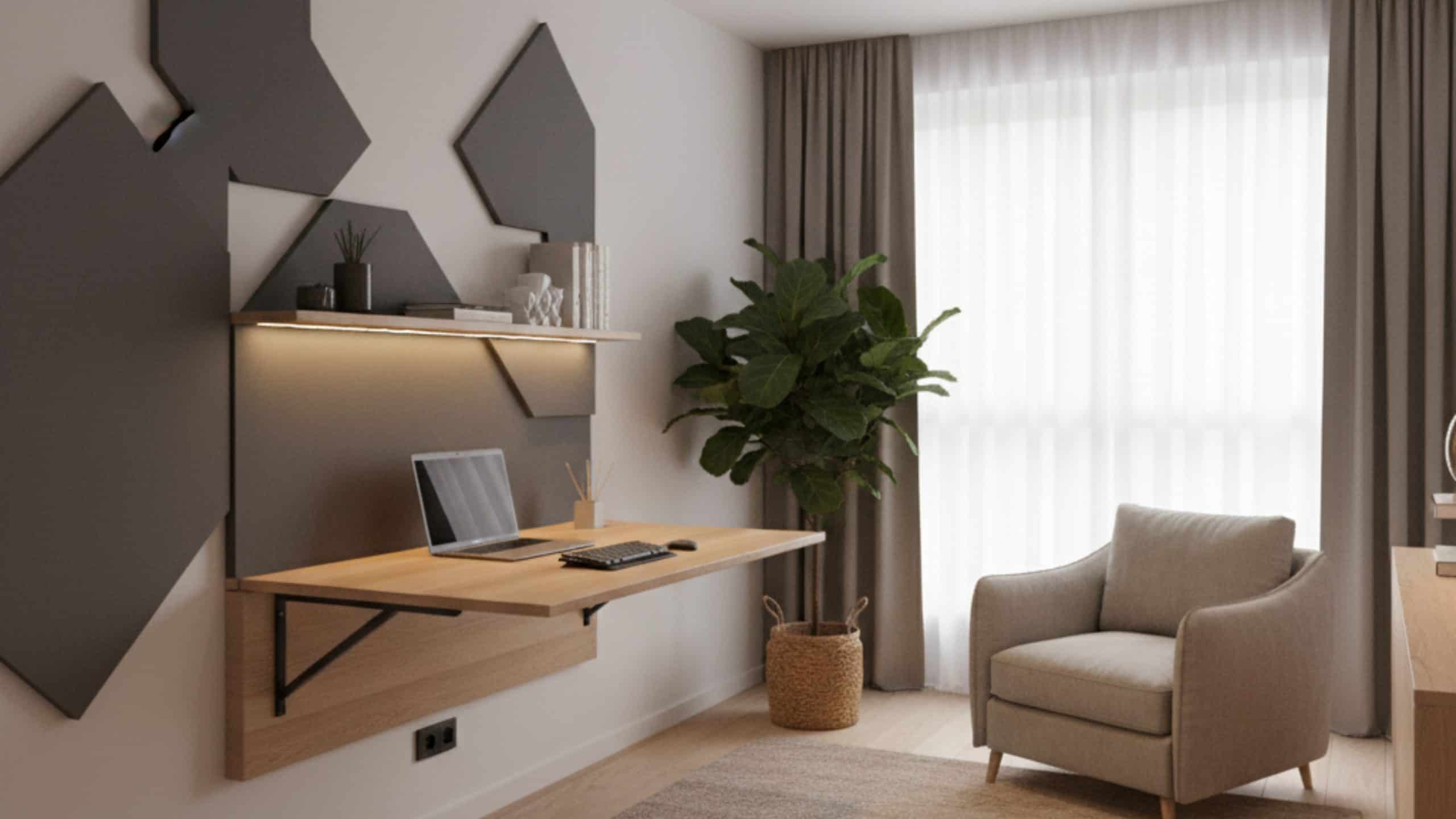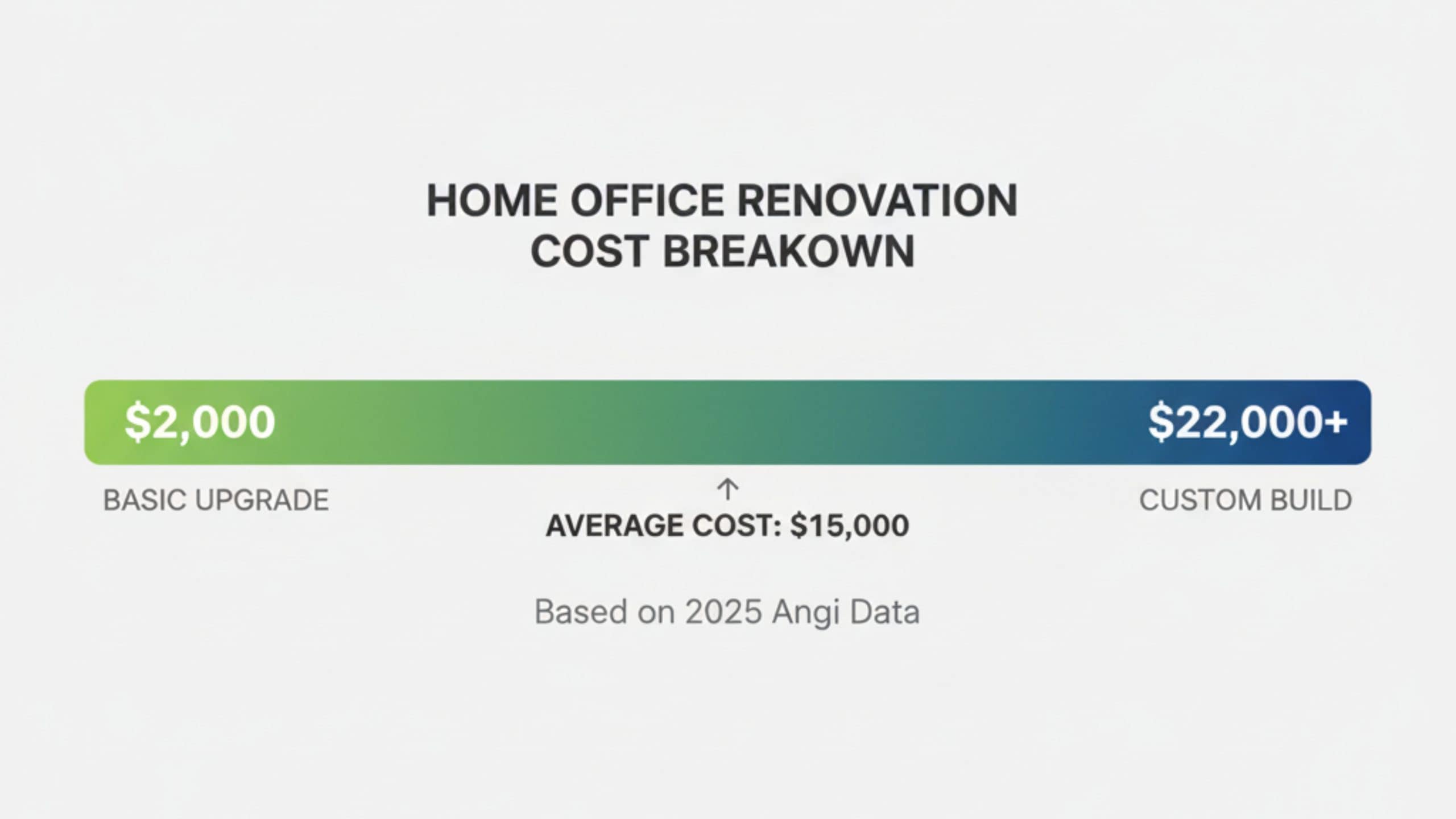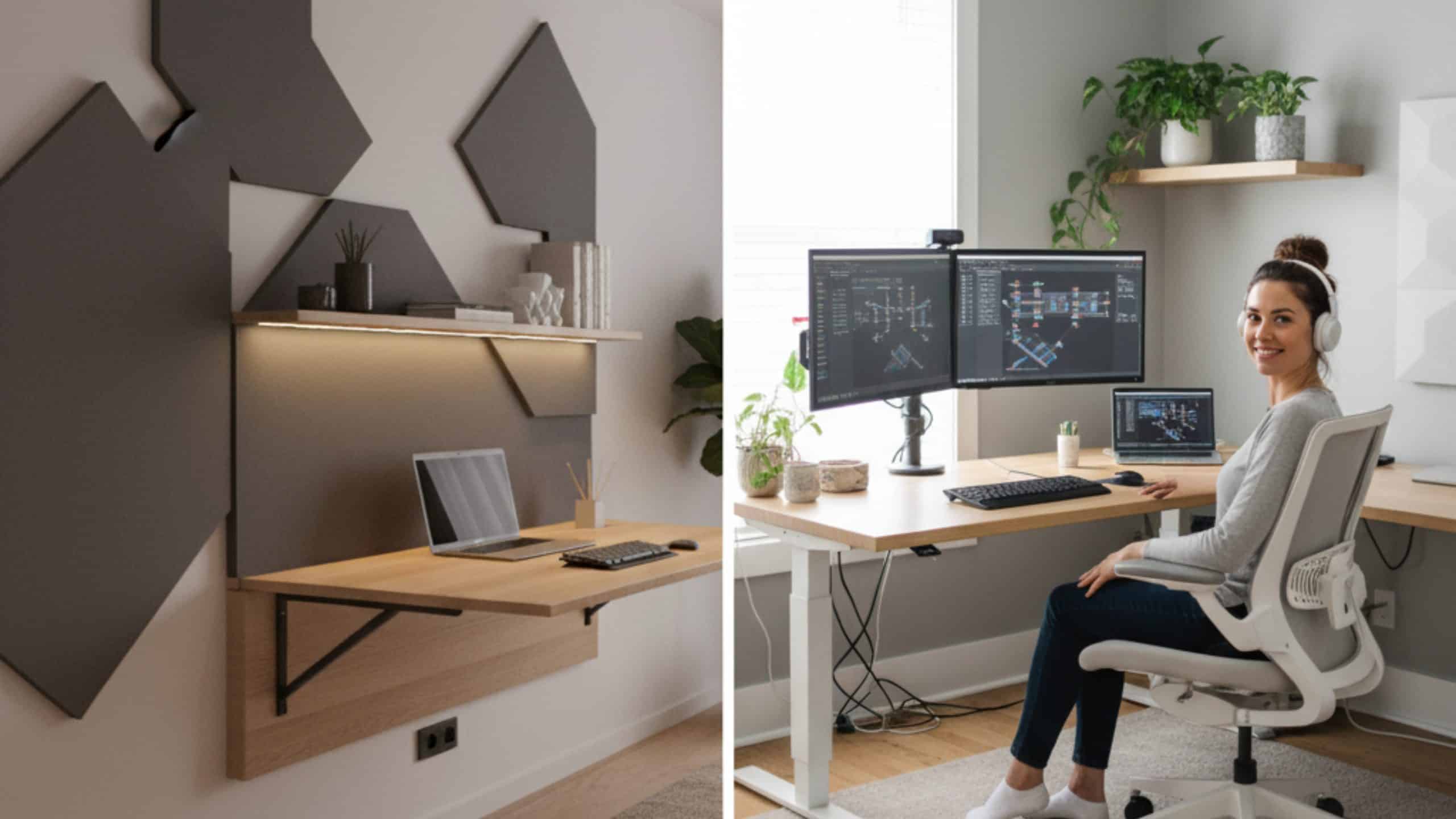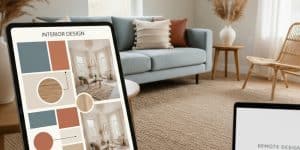Remote work has shifted from a temporary pandemic workaround to a permanent way of operating for millions of professionals. In 2023, roughly 19.5 % of Americans worked remotely, and over 58 % of the workforce reported that they could work remotely at least part of the time.
Many companies have dismantled or downsized their offices as employees embrace hybrid or fully remote schedules. This shift created an unexpected problem, “how do you renovate a home office” when that space is critical for earning a living? There’s an irony in needing to demolish and rebuild the very room that allows you to do your job.
Work-from-Home Office Renovation Story
Jessica, a software architect in Austin, faced that dilemma when her employer announced a permanent remote‑first policy. Her dining‑room‑table setup wasn’t cutting it anymore, she needed a soundproof, ergonomic space for coding and client meetings.
Taking a week off for a remodel would have derailed project deadlines, yet continuing to work from the dining table meant ongoing neck pain and interruptions. Her story highlights the challenge thousands of remote workers face, “how do you create the perfect work‑from‑home office while maintaining productivity and income?”
This guide dives deep into the work‑from‑home office renovation process. It covers productivity protection, budgeting, design and technology enhancements, temporary workspace solutions, contractor coordination, return on investment (ROI) considerations, and the long‑term value of a dedicated remote workspace.
For more details on how we help professionals manage projects remotely, explore our remote home renovation services.
Whether you’re converting a spare bedroom or building an addition, you’ll find detailed steps to help you create an efficient, comfortable, and future‑proof home office.
1. The Remote Worker’s Renovation Challenge
Renovating a workspace that you actively use requires more planning than a typical home improvement project. Contractors often assume you can avoid the construction area, but remote workers rely on their home offices every day. Key concerns include maintaining productivity, ensuring continuity, protecting confidentiality, and optimizing space for multiple functions.
Productivity Protection
Remote workers can’t simply “work around” the noise and clutter of a renovation. Consider these issues:
-
Noise and Video Calls: Drilling, hammering, and demolition may interrupt video meetings. Scheduling calls around construction or investing in noise‑cancelling microphones can help. Alternatively, coordinate with contractors to avoid loud work during key meeting times.
-
Connectivity: Reliable internet access is non‑negotiable. Plan for temporary internet cables or wireless routers to keep you online even if your office network gets disconnected.
-
Confidentiality: Clients expect privacy. Storing sensitive files away from the renovation zone and establishing secure digital storage ensures information isn’t exposed to contractors.
-
Scheduling: Coordinate your meeting schedule with renovation phases. For example, book calls in the early morning or late afternoon when crews aren’t on site.
Continuity Planning
To minimize income disruption, create a temporary workspace before construction begins. Options include:
-
Another Room: Set up a desk in the bedroom or dining room with minimal equipment (laptop, monitor, headphones). Label cables and equipment to ensure quick reconnection.
-
Co‑Working Spaces: Rent a desk at a local co‑working centre for the loudest phases. Many co‑working offices offer hourly or daily rates.
-
Friends or Family: Working from a relative’s house for a few days can keep you productive if you have stable internet and privacy.
-
Backup Internet and Power: Have a mobile hotspot or secondary internet connection. A UPS (uninterruptible power supply) can prevent abrupt shutdowns during electrical work.
Space Optimization for Dual Purposes
Home offices often double as guest rooms, hobby areas, or personal retreats. When renovating, think about:
-
Video Conferencing Zones: Designate a background with good lighting, neutral colours, and minimal distractions. Add adjustable lighting for professional video quality.
-
Storage: Incorporate built‑in cabinets or closets to store work materials as well as personal items. Modular shelving can hide printers and cables.
-
Acoustics: Soft furnishings (rugs, curtains, acoustic panels) reduce echo during calls and improve focus. Soundproofing insulation in walls reduces household noise.
-
Ergonomics: Choose adjustable desks, chairs, and monitor arms to prevent repetitive‑strain injuries. An ergonomic workspace reduces fatigue and increases productivity.
-
Flexible Furniture: Mobile desks and fold‑away tables allow you to reconfigure the space for meetings, focused work, or relaxation.
2. Work Pattern Analysis and Strategic Planning
Before drawing up blueprints, assess how you actually work. Many remote professionals discover that their assumptions don’t match their habits.
A data‑driven analysis ensures your renovation supports productivity and well‑being.
Work Pattern Analysis
Track your activities for at least two weeks. Note when you are most productive, how often you hold meetings, and which equipment you use. For expats and executives balancing global responsibilities, our renovation services for global executives ensure projects run smoothly across time zones.
Questions to consider:
-
When are your peak focus hours? Do you need bright sunlight in the morning or prefer low lighting in the afternoon? Place your desk accordingly.
-
How many meetings do you have, and what is their average duration? This influences acoustic needs and camera setups.
-
What storage do you require? Are you mostly digital, or do you have physical files, books, and devices?
-
What technology do you use? Plan for cable management, power outlets, and network ports. Document how many monitors, printers, and chargers you need.
-
Do you meet clients or colleagues in person? Consider a small meeting table or seating area if you occasionally host visitors.
Future‑Proofing Considerations
Remote work patterns evolve. To avoid another renovation in a few years, think ahead:
-
Career Growth: You may transition into managerial roles requiring more meetings or interviews. Design a versatile space with adjustable lighting and camera angles.
-
Hybrid Work: If you plan to return to an office part‑time, ensure your home office can be repurposed when you’re not using it full‑time. Built‑in storage and fold‑down desks offer flexibility.
-
Technological Upgrades: Leave space for new devices, additional monitors, or VR/AR equipment. Install extra outlets and conduits for future wiring.
-
Family Changes: A growing family may require converting the office into a bedroom later. Opt for fixtures that can be removed or reconfigured.
-
Remote Work Trends: Stay aware of emerging tools (virtual meeting pods, AI‑enabled cameras) and design your office to accommodate them.
3. Budget Planning and Cost Considerations
Renovating a work‑from‑home office can cost anywhere from a few thousand dollars to tens of thousands, depending on size, materials, and whether you build an addition. According to Angi’s 2025 data, the normal range to build a home office is between $2,000 and $22,000, with an average cost of around $15,000.
Converting an existing room can cost as little as $1,500, while adding a new room can exceed $27,500. Homeowners typically spend $50 to $200 per square foot on remodeling within the existing layout, and building an addition costs $80 to $200 per square foot.
Cost by room size
Here is a breakdown of typical remodeling costs based on room size:
| Office size (feet) | Estimated cost range |
|---|---|
| 8 × 8 (64 sq ft) | $3,200–$12,800 |
| 9 × 9 (81 sq ft) | $4,050–$16,200 |
| 10 × 10 (100 sq ft) | $5,000–$20,000 |
| 12 × 12 (144 sq ft) | $7,200–$28,800 |
| 15 × 15 (225 sq ft) | $11,250–$45,000 |
These figures include flooring, paint, electrical upgrades, and basic fixtures. High‑end finishes—like custom cabinetry, specialized acoustics, or integrated smart home systems—will push costs toward the upper range or beyond.
Professional services costs
Labor is a significant portion of renovation budgets. Angi notes that hiring a general contractor can cost anywhere from $250 to $58,000, depending on the scope, with homeowners spending around $4,000 on average.
Contractors manage permits, hire subcontractors, coordinate schedules, and address unforeseen issues. You may also need specialist professionals:
| Service | Typical cost range |
|---|---|
| Interior designer | $50–$200 per hour |
| Electrician | $160–$535 |
| Internet technician | $185–$675 |
| Handyperson | $180–$690 |
| Painter | $300–$2,800 |
| Flooring specialist | $1,530–$4,855 |
| HVAC installation | $2,000–$3,000 |
| Renovation consultant | $50–$150 per hour |
Materials and hidden costs
Material costs for home offices vary widely, from $1,245 to $25,300, with labour accounting for approximately 20% and materials 80%. More expensive items include soundproofing, custom doors and windows, and built‑in storage. Don’t forget to budget for:
-
Technology Upgrades: New routers, network switches, smart lighting, and high‑resolution cameras.
-
Permit Fees: If you’re altering load‑bearing walls or adding an extension, you’ll need permits.
-
Furniture: Quality desks, chairs, and storage can add several thousand dollars.
-
Temporary Workspace Costs: Co‑working memberships or travel to alternative locations.
-
Contingency Fund: Allocate at least 10 % of your budget for unexpected issues like structural repairs or supply chain delays.
Financing options
If you don’t have cash on hand, consider financing your renovation:
-
Home Equity Loans: Borrow against your home’s equity. Interest rates are often lower than personal loans.
-
Personal Loans: Unsecured loans typically have higher rates but don’t require collateral.
-
Credit Cards: Useful for smaller purchases, but interest rates can be high. Use rewards cards to offset costs if you can pay them off quickly.
-
Employer Stipends: Some companies offer allowances for home office improvements. Check with HR.
-
Tax Deductions: If you’re self‑employed or use part of your home exclusively for work, certain expenses may be tax‑deductible. Consult a tax professional.
4. Design and Productivity Enhancements
A well‑designed office doesn’t just look good; it directly influences productivity, creativity, and well‑being. According to a Stanford study of 16,000 workers over 9 months, working from home increased productivity by 13% due to fewer breaks, quieter environments, and higher job satisfaction.
In that same study, workers also reported improved work satisfaction, and attrition rates were cut by 50%. Leveraging design principles can maximize these benefits.
Lighting and Natural Elements
Light affects mood and focus. Aim for a mix of natural and artificial lighting:
-
Daylight: Position desks near windows to take advantage of daylight. South‑facing windows provide consistent light throughout the day. Use blinds to reduce glare.
-
Layered Lighting: Combine overhead lighting with task lamps. Dimmable LED fixtures and smart bulbs allow you to adjust intensity and colour temperature based on the time of day.
-
Plant Life: Incorporate houseplants to improve air quality and create a calming atmosphere. Studies show that greenery reduces stress and boosts creativity.
-
Views: If possible, orient the desk so you can occasionally gaze at an outdoor view. Visual breaks enhance cognitive function.
Ergonomics and Furniture
Long hours at a desk make ergonomics critical:
-
Adjustable Desks: Sit‑stand desks allow you to change position throughout the day, reducing strain on your back and increasing circulation.
-
Chairs: Invest in a chair with lumbar support, adjustable height, and armrests. Test chairs in person to ensure they fit your body.
-
Monitor Placement: The top of your monitor should be at or slightly below eye level, about an arm’s length away.
-
Keyboard and Mouse: Ergonomic keyboards and vertical mice reduce wrist strain.
-
Flooring: Soft flooring (carpet or anti‑fatigue mats) cushions your feet when standing.
Acoustics and Soundproofing
Noise is one of the biggest distractions for remote workers. Solutions include:
-
Acoustic Panels: Mount foam or fabric panels on walls and ceilings to absorb echoes.
-
Rugs and Curtains: Add plush rugs and thick curtains to dampen sound and create a warmer feel.
-
Seals and Insulation: If you’re renovating walls, add insulation and weatherstripping around doors to block external noise.
-
White Noise Machines: Use ambient sound devices or apps to mask construction noise during the renovation.
Smart Technology and Connectivity
Integrate technology into your remodel:
-
High‑Speed Internet: Invest in gigabit fibre or the fastest service available. Use mesh Wi‑Fi or wired Ethernet for reliability.
-
Power and Charging: Install abundant outlets, USB‑C ports, and surge protectors. Consider floor outlets for a cleaner look.
-
Video Equipment: High‑resolution webcams, ring lights, and adjustable mounts ensure you look professional on camera.
-
Smart Home Controls: Use voice assistants or apps to control lighting, climate, and shades. Automations (e.g., turning on lights at 8 a.m.) maintain a consistent schedule.
-
Air Quality: Add sensors for temperature, humidity, and CO₂. Good air quality improves focus.
We specialize in setups that meet the demands of high-performance careers, see how we help tech professionals renovate their work from home office.
Personalization and Aesthetics
Your office should inspire you. Select colours and finishes that reflect your personality and energize your workday:
-
Colour Psychology: Blues and greens promote calm and focus, while yellows and oranges stimulate creativity. Neutral palettes reduce distraction and pair well with pops of colour. Design that balances both work and leisure needs is crucial; our guide on remote Airbnb interior design shares lessons that apply equally to professional home offices.
-
Textures and Materials: Natural wood, cork, linen, and bamboo create a warm environment. Avoid surfaces that produce glare.
-
Artwork and Decor: Choose artwork that motivates you. A corkboard or whiteboard for brainstorming can double as wall art.
-
Multi‑Purpose Layouts: Use sliding doors, Murphy beds, or fold‑down tables if your office must double as a guest room.
Home offices are increasingly seen as an investment feature. See how property investors maximize value with strategic renovations.
5. Working Without Your Office: Temporary Solutions
Even the best‑planned renovation means you’ll be without your office at some point. Rather than scrambling, set up a temporary arrangement:
-
Dedicated “Pop‑Up” Office at Home: Transform a bedroom, hallway nook, or kitchen table into a mini office. Use a portable monitor, a collapsible desk, and a small filing box. Keep cables organized and label them to make reinstallation easier.
-
Co‑Working Memberships: Many coworking spaces offer flexible passes (daily or weekly). These spaces provide quiet rooms, high‑speed internet, and printing services. Some offer conference rooms for professional client meetings.
-
Public Libraries: Libraries often have private rooms or quiet areas, free Wi‑Fi, and minimal distractions.
-
Family and Friends’ Homes: If you need peace during demolition, temporarily working from a trusted friend’s house can help. Discuss expectations and set boundaries.
-
Vacation Rentals or Hotels: Short stays in rental properties provide privacy and comfort. Negotiate a weekly rate to lower the cost.
When using a temporary space, replicate your regular office setup as much as possible (monitors, keyboard, headphones). Keep your digital files synced to the cloud so you can work seamlessly between locations. Inform clients about the renovation and reassure them that confidentiality and quality will not be compromised.
6. Choosing and Managing Contractors Remotely
Selecting trustworthy professionals is vital when you can’t be on site all day. Vetted contractors, clear communication, and remote oversight tools help protect your investment and schedule.
Vetting Contractors
-
Get Referrals and Reviews: Ask friends, neighbours, and online communities for recommendations. Check review sites and confirm contractors are licensed and insured.
-
Interview Multiple Candidates: Discuss experience with remote clients. Do they provide virtual updates, photos, and videos? Can they accommodate scheduling around your work hours?
-
Detailed Proposals: Request itemized quotes with labour, materials, timeline, and payment schedule. Avoid vague estimates.
-
Contracts and Warranties: Sign a detailed contract outlining scope, deadlines, change order procedures, and warranty terms.
Communication and project management
-
Digital Dashboards: Use project management software (Trello, Asana, Buildertrend) that both you and your contractor can access. Track tasks, deadlines, and costs in real time.
-
Regular Check‑Ins: Schedule weekly video calls to review progress, discuss issues, and adjust timelines. Ask for photos or live video walk‑throughs.
-
Site Visits: Arrange occasional on‑site visits during critical phases. Even if you work elsewhere, dropping in ensures quality control.
-
Clear Escalation: Identify who to contact if you’re unhappy with workmanship or schedule delays. Document all communication.
Security and Confidentiality
When strangers enter your home, privacy matters:
-
Secure Sensitive Documents and Devices: Lock file cabinets and store hard drives or laptops in a safe. Use strong passwords and two‑factor authentication for digital files.
-
Restrict Access: Keep doors closed to other rooms and install temporary locks.
-
Surveillance: Consider using indoor cameras to monitor work areas. Inform contractors of the cameras (check local laws about recording).
7. Technology Tools and Resources
Technology plays a crucial role in planning, executing, and enjoying your renovated office. Tools fall into three categories: planning, collaboration, and environmental control.
Planning Tools
-
3D Design Software: Programs like SketchUp, Sweet Home 3D, and RoomSketcher allow you to visualize layouts, test furniture placement, and experiment with colours.
-
Augmented Reality (AR) Apps: Some retailers offer AR apps that let you see how furniture and decor look in your space before buying.
-
Budgeting Calculators: Online calculators (e.g., from home improvement stores) estimate costs based on room size and materials. Combine them with the cost ranges discussed earlier to fine‑tune your budget.
-
Permit Checkers: Some municipal websites offer permit requirement checkers. Ensure your project complies with local codes.
Collaboration and Productivity Tools
-
Project Management Platforms: As mentioned, tools like Asana, Monday.com, and Basecamp keep everyone on schedule.
-
Video Conferencing: Zoom, Microsoft Teams, and Google Meet remain staples for virtual meetings. Invest in quality audio and lighting to appear professional.
-
Document Collaboration: Use cloud services (Google Drive, Microsoft 365, Dropbox) to share files securely with contractors and designers.
-
Time‑Tracking and Focus Apps: Tools such as Pomodoro timers, distraction blockers, and productivity analytics help maintain focus while working outside your usual office.
Environmental Control and Smart Devices
-
Smart Thermostats: Maintain comfortable temperatures automatically. Some integrate with sensors to adjust based on occupancy.
-
Smart Lighting Systems: Set schedules, adjust brightness, and change colour temperature to match natural rhythms.
-
Air Purifiers and Humidifiers: High‑quality indoor air reduces fatigue and headaches.
-
Noise‑Cancelling Headphones and Speakers: Even with soundproofing, headphones provide personal control over your auditory environment.
8. ROI: Why a Dedicated Office is Worth it
Home office renovations can feel expensive, but they offer substantial returns, both financial and non‑monetary.
Financial ROI
-
Property value: Adding square footage often yields a higher return on investment than cosmetic upgrades. Angi estimates the ROI of a room conversion at around 10 % to 20 %, while a home addition can yield about 50%. For a home valued at $300,000, a 50 % ROI on a $25,000 addition could add $12,500 in value. Actual returns vary by location, market conditions, and quality of workmanship.
-
Tax deductions: If you’re self‑employed, you may deduct a portion of your mortgage, utilities, and renovation costs for the percentage of your home used exclusively for business. Consult a tax professional to ensure compliance.
-
Employer stipends: Some companies provide allowances or reimbursements for home office improvements, reducing your out‑of‑pocket expenses.
Dedicated spaces also attract buyers and renters; our insights on remote real estate investing highlight this growing trend.
Productivity and Well‑Being ROI
Beyond financial gains, a dedicated office improves your quality of life and job performance. Studies show that working from home can increase productivity by 13% and reduce attrition by 50%.
Additional benefits include:
-
Reduced Commute Time: Saving even one hour per day frees up five extra hours each workweek for family, hobbies, or rest.
-
Greater Autonomy: Control over your environment allows you to tailor lighting, temperature, and noise to your preferences, boosting comfort and focus.
-
Improved Work‑Life Balance: 71 % of surveyed employees reported that working outside the office improved their work/life balance.
-
Mental Health: A well‑designed personal office can reduce stress. Incorporating plants, natural light, and personalized decor creates a calming oasis.
-
Professional Image: An attractive, quiet space enhances credibility on video calls and client meetings.
Avoiding the Hidden Costs of Not Renovating
Delaying a renovation can have its own costs:
-
Decreased Productivity: Working at the dining table or in a makeshift space leads to poor posture, distractions, and inefficiencies.
-
Health Problems: Inadequate ergonomics contribute to back pain, eye strain, and fatigue. Medical bills and time off can exceed the cost of new furniture.
-
Lost Opportunities: Without a professional space, you may decline client meetings or new projects. A dedicated office signals seriousness and competence.
Not sure where to start? Take our quick 2‑minute renovation assessment to identify your needs and priorities.
9. Case Study: Jessica’s Remote Office Transformation
Jessica’s journey illustrates how careful planning can turn a renovation challenge into a career boost. As a software architect, she needed a quiet space with multiple monitors, ample storage, and a reliable internet connection. She followed these steps:
-
Work Analysis: She tracked her daily activities and realized her peak coding hours were between 8 a.m. and noon. She also discovered that she spent 30 % of her time on video calls, so acoustic treatment was essential.
-
Budget and Scope: With a budget of $18,000, she decided to convert her rarely used guest room (12 × 12 feet) rather than build an addition. She hired a general contractor and an interior designer to keep the project on time and on brand.
-
Temporary Workspace: Jessica set up a makeshift office in her living room with a foldable desk, monitor, and noise‑cancelling headphones. She worked from a co‑working space during the loudest demolition days.
-
Design: She installed a sit‑stand desk, ergonomic chair, and built‑in bookshelves. Acoustic panels and thick curtains absorbed sound. A custom L‑shaped desk accommodated three monitors and a laptop. She added a small table for meetings with local clients.
-
Technology: Jessica upgraded to gigabit internet, added wired Ethernet ports, installed a smart thermostat, and integrated voice‑controlled lighting.
-
Outcome: The project finished in four weeks, two days ahead of schedule. Within a month, Jessica reported fewer headaches, improved posture, and better concentration. She closed two new clients after impressing them with her professional video setup. Her house appraised 8% higher due to the upgraded space.
Still have questions about remote renovations? Visit our FAQ page for answers to the most common concerns.
10. Conclusion: Building Your Future Workplace at Home
Remote work isn’t a passing trend; it’s a fundamental shift in how we live and earn. Crafting a work‑from‑home office renovation plan that balances productivity, comfort, budget, and future adaptability is critical to your long‑term success.
By analyzing how you work, planning for temporary disruptions, budgeting wisely, leveraging smart design and technology, and evaluating the ROI, you can transform a spare room or new addition into a powerhouse home office.
Jessica’s experience demonstrates that investing in the right space pays dividends in productivity, well‑being, and property value. Armed with cost estimates (from $2,000 for a simple upgrade to $22,000 or more for a custom build, you can choose a scope that fits your needs.
Remember that a dedicated workspace yields returns far beyond financial metrics, better focus, improved work‑life balance, and a space you’re proud to show on camera.
Ready to start your own home office renovation? With careful planning, your remote office can become the cornerstone of a productive, healthy, and rewarding remote career. Schedule a quick call with our team to discuss options.
